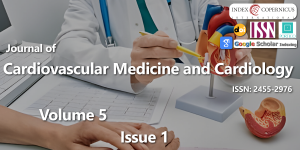Surgical management of embolised occlude devices and its complications-Single centre experience of ten years at Grant Medical College, Mumbai, Maharashtra
Main Article Content
Abstract
Introduction: In this study, we have analyzed our experience in surgical management of device embolization after trans-catheter closure of atrial septal defect [ASD] and its complications.
Method: This study is a review of 27 patients out of 300 patients who underwent transcatheter device closure of ASD between august 2007 to august 2017, in whom the device embellished and surgery was required for its retrieval and ASD closure. Risk factors for device embolization, its management and subsequent prognosis were discussed.
Results: Emergency device retrieval with pericardial patch closure of ASD on cardiopulmonary bypass was done in each case. Most common site for device embolization was right atrium. Other site of embolization are right ventricle, left atrium and even in pulmonary artery. More than half patients had inadequate rims, 3 patients had developed pericardial tamponade post cardiac perforation. Three patients developed femoral artery thrombosis at the catheter puncture site for which embolectomy was required. One patient developed transient ischaemic attack on postoperative day one. All other patients recovered well.
Conclusion: Closure of ostium secondum atrial septal defects by percutaneous occlude devices has significant advantages, however device embolization continues to be a major complication with chances of added morbidity of vascular complications, stroke and transient ischaemic attacks. Patient selection is of as much importance as device selection to prevent patient –device mismatch. After device embolization, the device can be retrieved and the septal defect can still be closed surgically with good success and minimal morbidity if acted upon on an urgent basis.
Downloads
Article Details
Copyright (c) 2018 Suraj WN, et al.

This work is licensed under a Creative Commons Attribution 4.0 International License.
Gittenberger-de Groot AC, Moulaert AJ, Hitchcock JF (1980) Histology of the persistent ductus arteriosus in cases of congenital rubella. Circulation 62: 183–186. Link: https://goo.gl/FGbvDK
Nagre SW (2016) Atrial Septal Defect: Management Approach in Children. Ann Woman Child Health 2: 3-4. Link: https://goo.gl/p4XQ91
Pegoli W (2005) Pericardium and great vessels. In: Oldham KT, Colombiani PM, editors. Principles and Practice of Pediatric Surgery. 4th ed. Philadelphia, PA: Lippincott Williams & Wilkins 1019
Nagre SW (2016) Management of Patent Ductous Arteriosus – Short Review. Annals of Woman and Child Health 2: Link: https://goo.gl/LTcjWrs
Miao CY, Zuberbuhler JS, Zuberbuhler JR (1990) Prevalence of congenital cardiac anomalies at high altitude. J Am Coll Cardiol 12: 224–228. Link: https://goo.gl/B9nvfg
Nagre SW, Nagre MS (2015) Observational Study of Surgical Closure of Ostium Primum Atrial Septal Defect in Thirty Paediatric Patients. Ann Woman Child Health 1: 1-4. Link: https://goo.gl/jV9Vga
Nora JJ, Nora AH (1976) Recurrence risks in children having one parent with a congenital heart disease. Circulation 53: 701–702. Link: https://goo.gl/Tuo3bm
Nagre SW (2017) Atrial Septal Defect – Forgotten Treatment Guidelines. Acute Chronic Diss 1: e101. Link: https://goo.gl/ydMSwu
Pezzati M, Vangi V, Biagiotti R, Bertini G, Cianciulli D, et al. (1999) Effects of indomethacin and ibuprofen on mesenteric and renal blood flow in preterm infants with patent ductusarteriosus. J Pediatr 135: 733–738. Link: https://goo.gl/TWfXQH
Nagre SW (2015) Surgical removal of embolised atrial septal defect device from pulmonary artery. J Thorac Cardiovasc Surg 150: e55-57. Link: https://goo.gl/xzHr7Js





